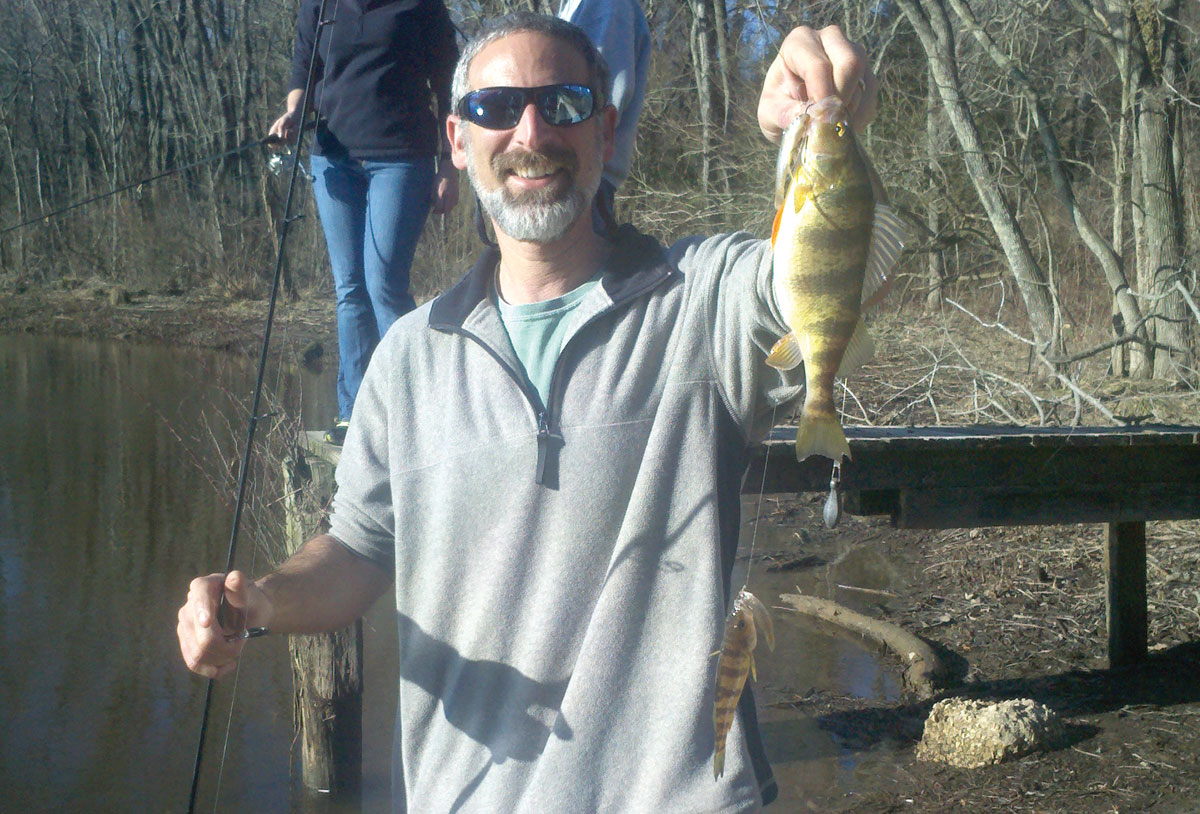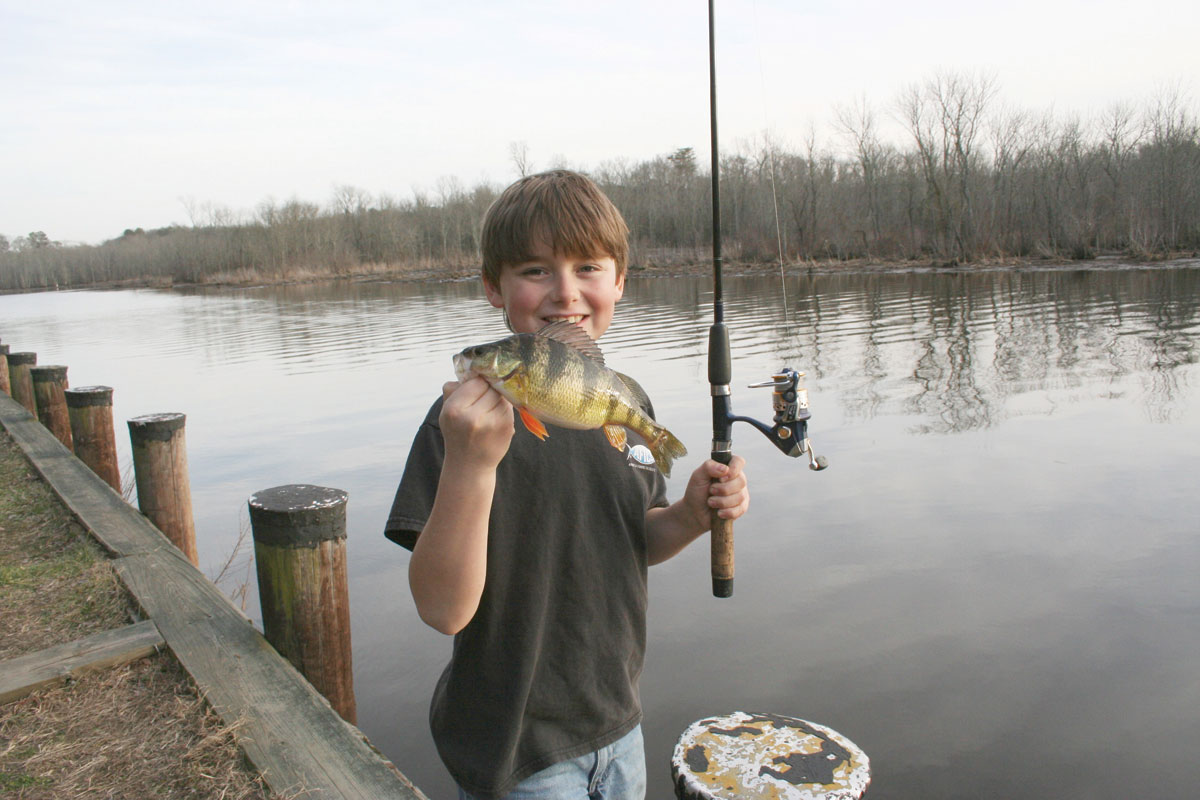We’ve suffered through Arctic Bomb Cyclones and Polar Vortexes for long enough – rejoice, for spring is just around the corner and Chesapeake Bay fishing is not far away, people! And many anglers in Delaware, Maryland, and Virginia who live in tidewater areas will ring in the new fishing season by joining in for the spring perch run. First will come the yellows, and then the whites will make their presence known. Whichever species is in prime form when you hit the creek, one thing is for sure: perch are great eating, they provide gobs of fast action, and their presence on the spawning grounds means that once and for all those freezing cold days and nights are behind us.

Most seasons, yellow perch will usually depart from their winter haunts and begin the spawning run in early to mid-March, depending on the weather and when the water temperatures rise up into the mid- to the low 50s. The length of daylight hours also has an influence on when the perch decide to spawn, so even during very mild winters they won’t begin leaving the pre-spawn staging areas much earlier. White perch will run a couple of weeks behind the yellows, with a week or two overlap that sometimes provides the best action.
The run can last between a month and six weeks, but by mid-April it’s usually a done deal – and by then most of us are too consumed with trophy stripers, a tog bite, the arrival of specks, and the other many fishing options that are busting loose during this time frame to be worried about perch any longer, regardless. Males arrive at the spawning grounds first and leave last, so catching lots of small fish (the males are usually significantly smaller) lets you know if the run is just beginning – or if it’s past its peak and winding down.
Ring Perch
Before we dive into yellow perch details, if you'd rather see it on the screen check out our How to Fish For Yellow Perch During the Spring Perch Run video:
Most of the time in most of the areas you’ll fish for yellows, bull minnow are the top bait. Grass shrimp come in a close second, but we need to note that unlike pre-season perch (which virtually always choose minnow over shrimp) sometimes, having some grass shrimp on hand will save the day when for whatever reason the fish do prefer them.
With both baits, a shad dart tied to the end of four- to six-pound test ultralight gear completes the rest of the rig. Red/yellow is the classic color pattern, but pink, white, and chartreuse all excel at times. If you don’t have a rod and reel in this class you can use heavier gear, but add a barrel swivel and a few feet of light leader – and recognize that your casting distance and sensitivity will suffer a bit.
You can cast and retrieve the baited dart (add minnow by lip-hooking them, and with shrimp go through the bottom of the head just aft of the eyes and come out through the top). Keep the retrieve smooth and slow, and in deep areas, allowing the dart to sink down to or near the bottom is often the best move.
In most areas of relatively slow-moving water the dart/bait method is the top tactic, but in deep holes particularly on low tides, reverting to a bottom rig and letting it sit on bottom in the deepest spot possible is often more productive. Conversely, you can also try floating the dart or a similar offering three feet or so under a bobber. This tactic usually works best when the tide is high, and fish have moved up near the banks. Added bonus: in many areas you’ll also catch some crappie and/or pickerel using this method.
White Flight
There’s usually a period of one or two weeks where the yellows haven’t quite tapered off just yet, and the whites start to show up in good numbers. Then when the yellow perch spawn is complete, white perch become the name of the game. At this point, it’s time to forget about the bull minnow and instead stick entirely with grass shrimp. Shad darts and similar small jigs remain the best way to get your offering to the fish. Again, hook the shrimp on the dart at the head, and fish it slowly across the bottom. For some reason, the bobber method seems to work better with whites than yellows, especially when the fish move into relatively shallow water up on the banks.
Lure purists may want to instead try casting small Mepps spinners. Although minnow don’t seem to be the favorite bait of white perch, the vibrating blade of a Mepps regularly gets them chewing. One down-side: those treble hooks are a pain in the keister to deal with, and are hard on the fish when you release them. Small two- to three-inch streamer flies are also quite effective on white perch at times, though you’ll need to either fly cast them or rig them in tandem with something that has a bit of weight, in order to cast them effectively. A two-inch tube jig on a 1/16 th ounce leadhead usually provides enough to get the job done, and will also catch plenty of perch (try red/white and blue/white combinations). Note, however, that if you use an eight or 10 pound class rig as opposed to true ultralight gear, you’ll need more like 1/8 th of an ounce to get sufficient casting distance.

Delaware Delights
The C & D Canal maintains a healthy perch population, though significantly more whites than yellows, with Scott’s Run enjoying a spring run. The Christiana River/White Clay Creek complex also sees a good run, as does Indian River up-stream of Millsboro. Probably the most popular Delaware perch run hotspot, however, is a bit farther south at Seaford on the upper Nanticoke, and the stretch of Broad Creek between the Laural River Park and the Records Pond spillway (where there’s shoreline access).
Mayhem in Maryland
Anglers in northern Maryland will want to head for the North East River, which has a strong yellow perch run. Western shore anglers favor the Magothy (there’s shoreline access at Beechwood park, but note that the run here commonly starts and ends a bit earlier than most other spots), and the creeks off the Potomac. Nanjemoy (which has a public fishing pier that’s better for pre-season than during the actual run), Mattawoman, and the upper Wicomico at Allen’s Fresh (which has shoreline access by the Rt 234 bridge, but it’s best to have waders to get around to different spots) are all good possibilities.
The Eastern Shore of Maryland is well known for red-hot perch runs on the Tuckahoe River, especially at Hillsboro where you can park at the boat launch or just past the bridge. It gets crowded here on a nice weekend day, but it’s a long stretch so there’s usually room for everyone. Red Bridges on the Choptank is another Eastern Shore hotspot, but this one also gets cramped at times.
Check out Maryland Perchapalooza for more info on fishing for perch in the Old Line state.
Virginia is for Perch Lovers
There are countless creeks feeding Chesapeake tributaries in Virginia which maintain good perch runs, but the most surprising might be the Occoquan, all the way up near Alexandria. The Pamunky and Mattaponi Rivers are also both well-known for strong spring perch runs. Farther south the Northwest River is popular perch territory, and aside from boats, kayaks, and canoes, can be accessed from shore at multiple points in the River Park. Check out Three Top Spring Perch Run Hotspots for more details (scroll down because spot number three is the one of interest, to folks in this neck of the woods).
By Lenny Rudow